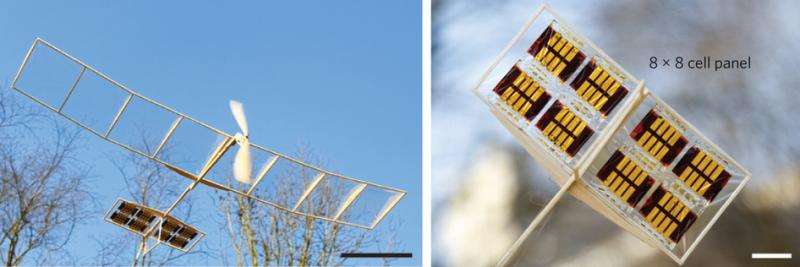August 27, 2015 report
Team creates functional ultrathin solar cells

(Phys.org)—A team of researchers with Johannes Kepler University Linz in Austria has developed an ultrathin solar cell for use in lightweight and flexible applications. In their paper published in the journal Nature Materials, the group describes how they created their solar cells and then tested them with miniature aircraft.
For engineers working with solar cells, two major goals are increasing the amount of electricity that can be harvested from a single cell, and making cells thinner and lighter while still producing the same amount or even more electricity as thicker cells. In this new effort, the research team has found a way to produce a solar cell that is just three micrometers thick, yet is still 12 percent efficient.
To create thinner cells, scientists have turned to new materials, one of which is organolead halide perovskites. They are direct band semiconductors and thus absorb light more efficiently than other materials. Unfortunately, they are also much more sensitive to environmental conditions, deteriorating when exposed to water, and worse as they do so, they tend to cause problems for metal electrodes. To make solar cells out of such materials requires adding protective coatings, which of course cause the end result to be both thicker and heavier.
To make their ultrathin solar cells, the team used a chromium oxide–chromium interlayer to protect the metal contacts against problems with the perovskite, then applied a clear polymer electrode that had been treated with dimethylsulphoxide. The result was an extremely thin one square meter solar cell that weighed just 5.2 grams and was capable of producing 120 watts of power, which the team notes, is a record for power per weight solar cells.
To test their cells, the researchers attached them to a miniature plane and blimp, and report that the cells work as envisioned. The only problem of course, is that the cells have a short lifespan—they are still at the mercy of both water and oxygen because the coatings do not last very long, just a few days, though under optimal conditions they found that cells could survive for up to several months. Still, that may be long enough for some applications, such as weather balloons, drones, etc. especially those that are able to use other means for protecting them.
More information: Flexible high power-per-weight perovskite solar cells with chromium oxide–metal contacts for improved stability in air, Nature Materials (2015) DOI: 10.1038/nmat4388
Abstract
Photovoltaic technology requires light-absorbing materials that are highly efficient, lightweight, low cost and stable during operation. Organolead halide perovskites constitute a highly promising class of materials, but suffer limited stability under ambient conditions without heavy and costly encapsulation. Here, we report ultrathin (3 μm), highly flexible perovskite solar cells with stabilized 12% efficiency and a power-per-weight as high as 23 W g−1. To facilitate air-stable operation, we introduce a chromium oxide–chromium interlayer that effectively protects the metal top contacts from reactions with the perovskite. The use of a transparent polymer electrode treated with dimethylsulphoxide as the bottom layer allows the deposition—from solution at low temperature—of pinhole-free perovskite films at high yield on arbitrary substrates, including thin plastic foils. These ultra-lightweight solar cells are successfully used to power aviation models. Potential future applications include unmanned aerial vehicles—from airplanes to quadcopters and weather balloons—for environmental and industrial monitoring, rescue and emergency response, and tactical security applications.
© 2015 Tech Xplore


















